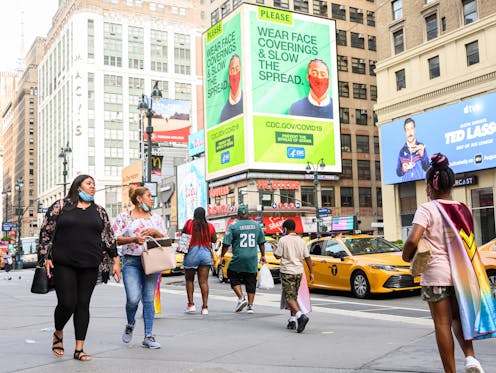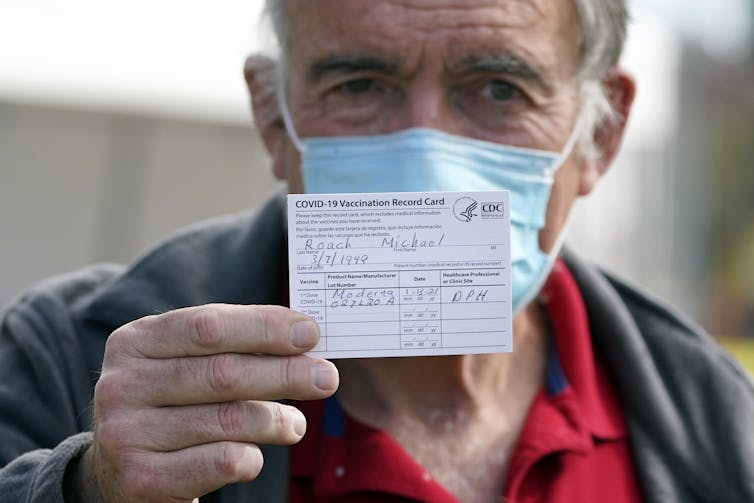COVID-19 public health messages have been all over the place – but researchers know how to do better
During the pandemic, clear and reliable health communication can literally be a life-and-death issue. Researchers who focus on the science of science communication highlight strategies that work.

Persuading people to get a COVID-19 vaccine remains a challenge even as more than a 120 million people in the U.S. have received at least one dose.
Public health officials have struggled to find persuasive and accessible approaches throughout the pandemic, from explaining where COVID-19 originated to how the virus spreads among individuals, along with steps to prevent its transmission, its inequitable impacts on people’s lives, and now relevant risks and benefits information about vaccines.
COVID-19 is not just a medical issue. It is also a social justice, economic and political issue. That makes it hard to figure out how best to share information about it, especially since messages come from a range of communicators – including elected officials, journalists, scientists, physicians and community leaders – and are delivered to diverse audiences.
And the science itself has been uncertain and evolving. New information can change what’s known almost daily, making clear, accurate communication a “moving target.”
As researchers focused on the science of science communication, we can suggest several communication strategies, based on a July 2020 report from the National Academies for Science, Engineering and Medicine, that encourage protective behaviors related to COVID-19.
Clear and open, even about uncertainty
Decades of research in risk communication show that people’s perception of their own risk is key to motivating them to take preventive measures. For that to work, public health messages must be clear, consistent and transparent.
One way to ensure that, especially for issues that have high uncertainty, like the pandemic, is for science and health messages to include context that connects the news to people’s concerns and prior experiences. What does risk or uncertainty about how the virus is transferred mean for the audience? How can they act on that information in their own lives? The “so what” of the message has to feel relevant. One approach, for example, is to emphasize how adoption of preventive behaviors – such as mask-wearing and hand-washing – leads to local businesses reopening and faster economic recovery.
Ensuring consistency in messaging, even for a rapidly changing issue, also means considering context – the bigger-picture processes shaping the issue. In other words, where do both the information and the uncertainty come from? What do scientists, policymakers and health care workers know or not know at this point? Then, most crucially, what are people doing to address that uncertainty and what can audiences still do to act in the face of it?
Tap into a crowd mentality
At various points during the pandemic, public health officials needed to persuade people to change aspects of their daily lives. To do this effectively, it helps to remember that people change their behavior and beliefs to better match what they perceive other people are doing – especially those they most identify with. It’s human nature to want to go along with social norms.
Health messages should avoid putting a spotlight on “bad” behaviors, since that can actually exacerbate the problem. Disproportionate attention paid to vaccine hesitancy or people refusing to wear masks, for example, gives the impression that these behaviors are more common than they actually are. Rather, attention to “good” behaviors, such as small business successfully implementing social distancing practices, can be more effective.

But even well-intended efforts to promote social norms, such as vaccination selfies, may provoke significant backlash, including jealousy, anger and feelings of injustice.
One way to avoid unintended backlash is to consider, before sharing, who is likely to see this message beyond the intended audiences. Are those who might see the message able to act on this information? If people can’t sign up for their own vaccination yet, a photo of a happy newly vaccinated person may make them feel angry and trigger negative feelings about systemic unfairness and resentment toward those who do have access.
Balancing the good news with the bad
The fear of a threat can motivate action. But a fear-based message often leads to people feeling helpless unless it’s paired with clear actions they can take to mitigate the threat.
Alternatively, hope is a powerful motivator, much more so and more consistently than fear or anger in many cases. Fortunately, for science communication in particular, surveys find that the majority of Americans remain hopeful about the promise of science to improve people’s lives.
Communicating hope can happen implicitly, through highlighting what does work and the benefits of actions. For example, clients following mask-wearing policies permitted many small businesses like hair salons to remain safely open.
What tends to be more common, especially in news coverage, is an emphasis on the negative – both in the current situation and in hypothetical futures and risks that could come if people don’t change course. You can see this focus in the coverage of gatherings that violate health regulations, like crowded beaches during spring break.
The weight of constant bad news reduces how equipped individuals feel to deal with a problem or avoid a risk. And this negative tendency can paint an unrealistic picture of an issue that has both wins and losses to report.
Without a fuller picture of the good news – what does work and what people are doing right – it becomes very difficult to envision how the world could look any different, or what anyone can do to move forward to a better place.
[Understand new developments in science, health and technology, each week. Subscribe to The Conversation’s science newsletter.]
Nothing to disclose.
Dominique Brossard and Todd Newman do not work for, consult, own shares in or receive funding from any company or organization that would benefit from this article, and have disclosed no relevant affiliations beyond their academic appointment.
Read These Next
What’s at stake in Trump’s executive order aiming to curb state-level AI regulation
In the absence of comprehensive federal AI regulation, states have stepped in. The Trump administration,…
Data centers need electricity fast, but utilities need years to build power plants – who should pay?
How many data centers will be built – and how much electricity they’ll need – is uncertain. Being…
Sleep problems and depression can be a vicious cycle, especially during pregnancy − here’s why it’s
Inadequate sleep can have negative downstream effects on everyday cognitive functioning and mental health,…





